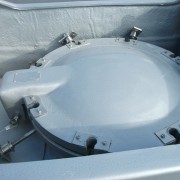Testing and Measuring Flexural Modulus of FRP
 What is Flexural Modulus?
What is Flexural Modulus?
There are many important properties of Fiber Reinforced Polymers (FRP) that are determined by international testing methods. These measurements of properties are particularly useful for quality control and specifications purposes. Flexural Modulus is an engineering measurement which determines how much a sample will bend when a given load is applied, as compared to Tensile Modulus which determined how much a sample will stretch when a given load is applied and Compressive Modulus which determines how much a sample will compress when a given load is applied. Because composites are non-isotropic(as opposed to metals for example) these additional material properties are required in order to predict the behavior under load which complicates the design problem for the inexperienced.
ASTM D-790 is one such standard testing method that is used to determine flexural properties of FRP. According to ASTM D-790, flexural properties may vary with specimen depth, temperature, atmospheric conditions, and the difference in rate of straining. For example, because the physical properties of many materials (especially thermoplastics) can vary depending on ambient temperature, it is sometimes appropriate to test materials at temperatures that simulate the intended end user environment.
According to ASTM D-790:
“These test methods cover the determination of flexural properties of unreinforced and reinforced plastics, including high-modulus composites and electrical insulating materials in the form of rectangular bars molded directly or cut from sheets, plates, or molded shapes. These test methods are generally applicable to both rigid and semirigid materials. However, flexural strength cannot be determined for those materials that do not break or that do not fail in the outer surface of the test specimen within the 5.0 % strain limit of these test methods. These test methods utilize a three-point loading system applied to a simply supported beam. A four-point loading system method can be found in Test Method D6272.”
Another common standard for testing flexural behavior is ISO 178. Similarly, this standard specifies a method for determining the flexural properties of rigid and semi-rigid plastics under defined conditions. A standard test specimen is defined, but parameters are included for alternative specimen sizes for use where appropriate.
It is important to note the differences between ASTM D-790 and ISO 178 standards. According to one well established leader in plastics testing, most commonly the specimen lies on a support span and the load is applied to the center by the loading nose producing three point bending at a specified rate. These parameters are based on the test specimen thickness and are defined differently by ASTM and ISO. For ASTM D790, the test is stopped when the specimen reaches 5% deflection or the specimen breaks before 5%. For ISO 178, the test is stopped when the specimen breaks. Of the specimen does not break, the test is continued as far as possible and the stress at 3.5% (conventional deflection) is reported.
This article was aimed at providing a snapshot portrait of the standard testing methods used for determining flexural properties of FRP.
Note:
ASTM International, formerly known as the American Society for Testing and Materials (ASTM), is a globally recognized leader in the development and delivery of international voluntary consensus standards.
ISO (International Organization for Standardization) is the world’s largest developer of voluntary International Standards.














